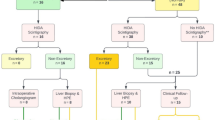Abstract
Background
There is a paucity of available literature describing the frequency of technical success of liver two-dimensional (2-D) ultrasound (US) shear wave elastography (SWE) in children and young adults.
Objective
To determine the frequency of technical success of liver 2-D ultrasound (US) SWE in children and young adults based on the interquartile range (IQR)/median of 10 shear wave speed (SWS) measurements.
Materials and methods
Clinical 2-D US SWE exams performed between February 2016 and March 2018 were retrospectively identified. Patient age and gender, median/mean liver stiffness (10 SWS measurements), IQR/median, abdominal wall thickness, body mass index (BMI) and serum alanine aminotransferase (ALT) were documented. The number of technically inadequate exams was calculated using three methods: 1) IQR/median >0.3, 2) IQR/median >95th percentile for our study population and 3) statistical outlier identification using the Tukey method. The effect of age, gender, median SWS, abdominal wall thickness, BMI, US transducer and ALT on measurement variability (IQR/median) was assessed using multivariable linear regression.
Results
During the study period, 573 exams were performed. Mean age was 12.6±7.1 years; 274 (47.8%) exams were in male patients. Average median liver stiffness was 1.75±0.47 m/s. Based on Methods 1, 2 and 3, 29/573 (5.1%), 28/573 (4.9%, IQR/median cutoff value=0.303) and 30/573 (5.2%) exams were technically inadequate. Predictors of IQR/median included age (P=0.03), abdominal wall thickness (P=0.003), median SWS (P<0.0001) and transducer (P<0.0001).
Conclusion
Approximately 95% of liver 2-D US SWE exams are technically successful based on IQR/median in children and young adults.




Similar content being viewed by others
References
Pinto RB, Schneider AC, da Silveira TR (2015) Cirrhosis in children and adolescents: an overview. World J Hepatol 7:392–405
Barr RG, Ferraioli G, Palmeri ML et al (2015) Elastography assessment of liver fibrosis: Society of Radiologists in Ultrasound consensus conference statement. Radiology 276:845–861
Dillman JR, Heider A, Bilhartz JL et al (2015) Ultrasound shear wave speed measurements correlate with liver fibrosis in children. Pediatr Radiol 45:1480–1488
Hwang JY, Yoon HM, Kim JR et al (2018) Diagnostic performance of transient elastography for liver fibrosis in children: a systematic review and meta-analysis. AJR Am J Roentgenol 211:W257–W266
Trout AT, Sheridan RM, Serai SD et al (2018) Diagnostic performance of MR elastography for liver fibrosis in children and young adults with a spectrum of liver diseases. Radiology 287:824–832
Tapper EB, Lok ASF (2017) Use of liver imaging and biopsy in clinical practice. N Engl J Med 377:2296–2297
Lin LI (1989) A concordance correlation coefficient to evaluate reproducibility. Biometrics 45:255–268
McBride GB (2005) A proposal for strength-of-agreement criteria for Lin’s concordance correlation coefficient. National Institute of Water & Atmospheric Research Ltd. https://www.medcalc.org/download/pdf/McBride2005.pdf. Accessed 20 Dec 2018
Nadebaum DP, Nicoll AJ, Sood S et al (2018) Variability of liver shear wave measurements using a new ultrasound elastographic technique. J Ultrasound Med 37:647–656
Boursier J, Zarski JP, de Ledinghen V et al (2013) Determination of reliability criteria for liver stiffness evaluation by transient elastography. Hepatology 57:1182–1191
Joshi M, Dillman JR, Towbin AJ et al (2017) MR elastography: high rate of technical success in pediatric and young adult patients. Pediatr Radiol 47:838–843
Wagner M, Corcuera-Solano I, Lo G et al (2017) Technical failure of MR elastography examinations of the liver: experience from a large single-center study. Radiology 284:401–412
Trout AT, Podberesky DJ, Dillman JR (2016) Consensus on elastography of the liver. Radiology 278:303
Trout AT, Dillman JR, Xanthakos S et al (2016) Prospective assessment of correlation between US acoustic radiation force impulse and MR elastography in a pediatric population: dispersion of US shear-wave speed measurement matters. Radiology 281:544–552
Author information
Authors and Affiliations
Corresponding author
Ethics declarations
Conflicts of interest
Drs. Dillman and Trout receive research support from Canon Medical Systems and Siemens Medical Solutions. Dr. Trout receives authorship honoraria from Wolters Kluwer and Reed Elsevier.
Additional information
Publisher’s note
Springer Nature remains neutral with regard to jurisdictional claims in published maps and institutional affiliations.
Rights and permissions
About this article
Cite this article
Northern, N.A., Dillman, J.R. & Trout, A.T. Frequency of technical success of two-dimensional ultrasound shear wave elastography in a large pediatric and young adult cohort: a clinical effectiveness study. Pediatr Radiol 49, 1025–1031 (2019). https://doi.org/10.1007/s00247-019-04396-3
Received:
Revised:
Accepted:
Published:
Issue Date:
DOI: https://doi.org/10.1007/s00247-019-04396-3




